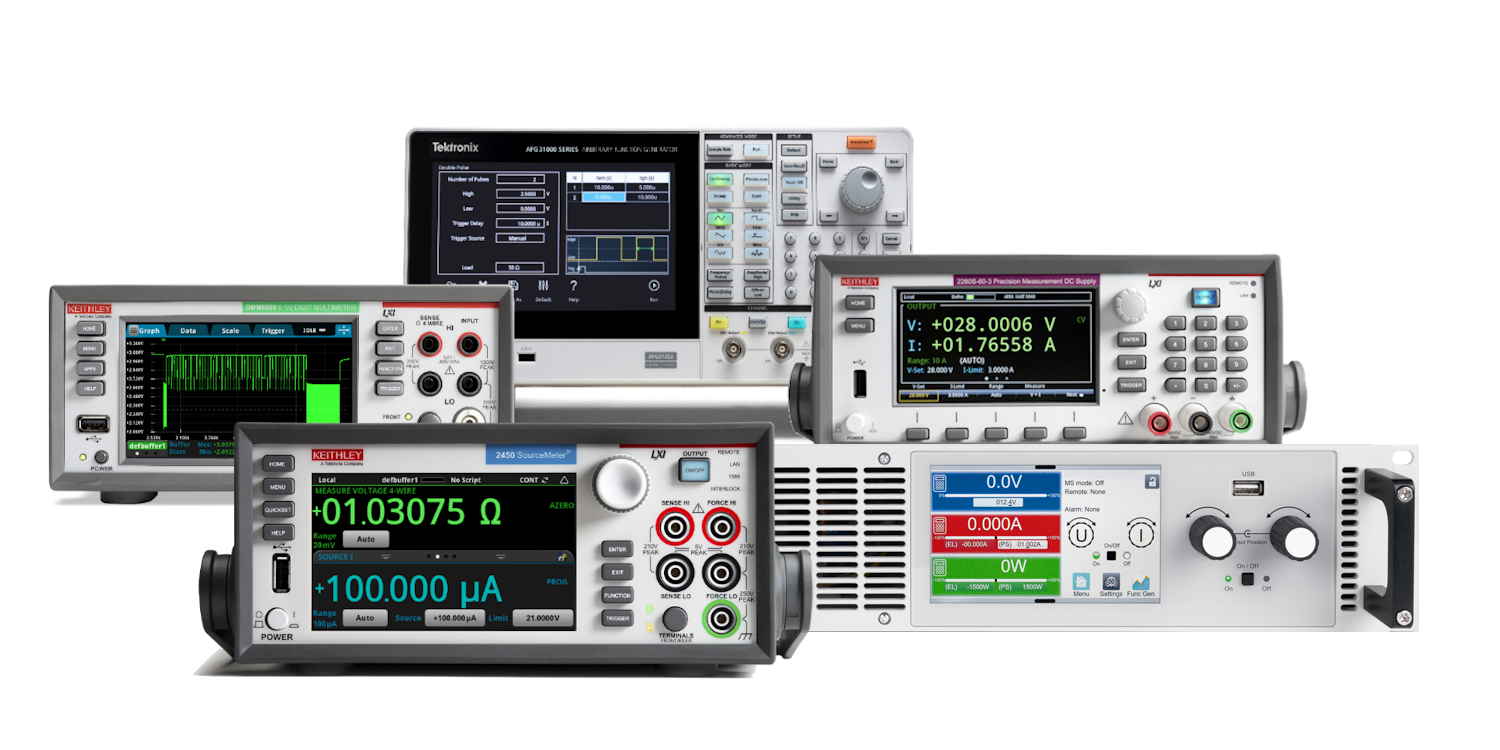SMUs vs. 5 Other Instruments

Source Measure Units (SMUs) are versatile instruments developed at the advent of semiconductors to characterize their complex behavior. Key capabilities of a SMU include 4-quadrant operation, precision measurement and sourcing, and high speed. These capabilities make SMUs similar to a range of other test and measurement equipment, yet different in meaningful ways. This blog explores some of the similarities and differences between SMUs and 5 other classes of instruments.

Caption: When we talk about quadrants in this blog, we’re referring to the I-V plane, with voltage on the x-axis and current on the y- axis. The quadrants I through IV of this industry standard diagram define how an instrument operates.
SMU v. Power Supply
SMUs are most commonly compared to a basic power supplies. Power supplies are designed to do 1 thing: output power. They do this by sourcing voltage and allowing current to flow. When they reach a voltage limit, they turn into current sources.
Power supplies typically only output positive voltage and positive current, thus operating only in quadrant I of our diagram above. They are also not measurement instruments; while they have a read-back feature for monitoring the output voltage and current, the readings usually have few digits and a large measurement error. You are expected to have another instrument for measuring when using a power supply.
In contrast, SMUs are faster, more precise, output less power, can source either voltage or current, and operate in 4 quadrants as opposed to 1. Since SMUs were developed for testing semiconductors, they can change their outputs much faster than a power supply in order to look at dynamic behavior. They have precision measurement capability for both voltage and current (typically 5½ or 6½ digit resolution), eliminating the need for another instrument to measure the voltage and current of a SMU. Like power supplies, SMUs can be voltage sources but they can also operate as current sources without having to be at a voltage limit. This makes SMUs better equipped for working with current-controlled devices like diodes and FETs
A SMU’s ability to operate in all 4 quadrants means that it can sink power (operate in quadrants II and IV) as well as source it (operate in quadrants I and III). This 4 quadrant capability is a defining unique feature of SMUs, and the next few instrument comparisons will bring up quadrant differences as well.
SMU v. Electronic Load
Electronic loads are basically the reverse of power supplies. They absorb power, operating in quadrant IV, but in all other ways behave almost identically to power supplies. Because electronic loads are so similar to power supplies, they compare to SMUs in much the same way. SMUs are generally faster and more precise, but can’t sink as much power.
Because electronic loads are sinking power, they can sometimes be replaced by resistor banks. A resistor bank, unlike an electronic load, doesn’t have any control over the power that it sinks, but can be used to sink an arbitrary amount of power (until they melt…). Some electronic loads, like those from EA Elektro-Automatik, are regenerative, meaning they can capture the power they sink and return it to the local energy grid, unlike traditional electronic loads or resistor banks which dissipate the power they sink as heat. This regenerative capability allows that power sunk power to be re-used at up to 96% efficiency.
SMU v. Bidirectional Power Supply
Bidirectional power supplies, a relatively recent development, are capable of operating in quadrants I and IV. If you’ve been following along, you can probably guess that they combine the capabilities of power supplies and electronic loads. Bidirectional supplies share the same comparisons to SMUs as those instruments, being generally slower, but able to work with much more power. The capability to source and sink power at positive voltage makes bidirectional supplies ideal for working with batteries, solar panels, and a host of other power sources.
Many EA Elektro-Automatik bidirectional power supplies are also capable of regenerative loading as discussed earlier with Electronic loads, allowing them to capture and re-use sunk energy, rather than dissipate it as heat.
SMU v. Signal Generator
SMUs are sometimes compared to signal generators like Arbitrary Function Generators (AFGs) or pulse generators (read our comparison of types of signal generators here). This is because of a SMUs ability to change outputs very fast compared with power supplies. Thus, with a little programming, or by using the firmware of the SMU, pulses and waveforms can be output.
But, because SMUs work with higher currents than signal generators, they are slower. Dedicated signal generators can output at very high frequencies with a large amount of control over repetition, slope, and more. Dedicated pulsing SMUs like the Keithley 2601B-PULSE can reach pulse widths as low as 10us (in voltage or current), but a limitation on going faster is that SMUs are expected to measure on their pulses which takes settling time, while pulse generators are just focused on outputting a fast pulse.
SMU v. DMM
Finally, we come to a test & measurement instrument that isn’t focused on sourcing. Digital Multimeters (DMMs) have evolved to contain many different measurement functions (like the 16 of the DMM6500), but fundamentally they measure voltage or current. Most DMMs measure resistance by sourcing a small current and measuring the resultant voltage. This current source might have a few different levels, but they are set by hardware inside the instrument without any fine control.
In theory, because a SMU measures voltage and current, it can perform many of the same functions as a DMM. However few SMUs, unlike DMMs, can perform the required calculations for things like frequency or capacitance out of the box. For simple measurements though, a SMU does quite well: a SMU can be made into a voltmeter by sourcing 0A, and can be made into an ammeter by sourcing 0V. In addition, because the measurement range of a SMU is tied to its source range, a DMM will often be able to measure higher voltages and currents than a SMU.
In measuring resistance, a SMU can source either voltage or current and measure the other, while also being able to set the source level to anything in range. This makes SMUs better equipped to measure very high resistances, where sourcing voltage can be more accurate than sourcing current, or very low resistance, which benefits from higher currents (see the Keithley Low Level Measurements Handbook to learn more about measuring resistance). Specialty SMUs like the Keithley 6430 can approach or exceed the precision measurement capabilities of electrometers even.
Conclusion
In summary, while Source Measure Units (SMUs) share similarities with other test and measurement equipment, they distinguish themselves through their versatility, precision, and their ability to synchronize the source and measure functions. Unlike power supplies, electronic loads, bidirectional power supplies, signal generators, and digital multimeters (DMMs), SMUs can both source and measure voltage and current with high precision, operate in four quadrants, and change outputs rapidly to observe dynamic behavior. This makes them exceptionally well-suited for testing semiconductors, materials, and components or systems that require precise control and measurement of electrical parameters.
Ultimately, the choice between these instruments depends on the specific requirements of the application, and many tests require multiple instruments. For tasks demanding high precision, versatility, and the ability to both source and measure, SMUs offer unparalleled capabilities, making them an invaluable tool in advanced electronic testing and characterization.

Caption: This table shows relative performance for some of the capabilities discussed in this blog.


